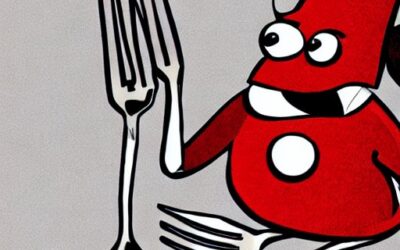Microwaves, Freezers & the rise of convenience food
As a kid, my mother didn’t like me to hang out in the kitchen too much, as I was just too curious for my good. Once I scratched a watermelon with a spoon for an hour to make watermelon juice. Feeling like a mix of a witch and a professional chef, I added a generous pinch of salt, ruining the batch. Another time I decided to heat a glass of water by putting it on the stove. I still remember my mother freaking out as it splattered into pieces. She wasn’t too keen to let my curious little hands experimenting with the microwave.
The mysterious, big box of heat was placed exceptionally high on the fridge. As I grew a bit older, I could reach it by climbing on a chair and was excited to start my semi-scientific experiments. One of my favorites turned out to be mozzarella. The white block would move like it’s alive before melting into a slightly more yellowish goo. “Don’t put your face close to the microwave while it is working!” she would reprimand me. “And after it stops, wait a few seconds to open it and put your hand in.” Something was up with this thing.
Whether you’re reheating yesterday’s take-out, nuking leftovers in the lunchroom, or popping corn for movie night, microwave ovens are so standard; for many people, it’s a real surprise to find themselves in a kitchen without one.
While we might complain about soggy pizza, weird cold spots, or scalding steam from pulling back the film on a piping hot ready meal, the microwave is hard to beat for sheer convenience. But the most significant food tech innovation of the 1940s wasn’t welcomed with open arms. It took decades of struggles before it rocketed to success in the 1980s.
So let’s look and learn from its history – from accidentally melting a chocolate bar in a scientist’s pocket, going for the most remarkable thing to a dangerous toy during the cold war, to becoming a home run because of a powerful alliance.
Microwaves: Brought to you by a chocolate bar
The invention of microwave cooking appears as a eureka! moment of creative thinking in science and design textbooks. In 1945 magnetron engineer Percy Spencer took a well-earned break from his experiments, only to find that the chocolate bar he’d stashed in his pocket had melted entirely. Rather than hunting for another snack, Percy made the intuitive leap that his equipment must be responsible.
As he continued to play around, he found that popcorn would pop and eggs would explode around the lab, with a patent for ‘cooking through the use of electromagnetic energy’ soon to follow. Whether it was quite this serendipitous or if it was more gradual is unclear, but Percy’s company, Raytheon, was undoubtedly in need of new ideas.
At the time, Raytheon mainly produced equipment for radar sets used to detect enemy planes and ships during WWII. The personal development of this technology was so important to the war effort that Percy Spencer himself received a medal for getting production rates from 17 tubes a week to 2600 a day. But with the arrival of peace, demand was dropping. Raytheon needed a new market for their technology. So they set about trying to revolutionize how people cooked.
They invested $100,000 in building the prototype microwave oven. This was a white-enameled giant named the ‘Radar-range’ in a company competition. It stood nearly 6 ft tall and weighed over 700lb (more than 300 kg), and it was twice as powerful as the average modern countertop microwave.
Company president Lawrence Marshall was so enthusiastic that he had it installed in his kitchen. This was quite a task since the Radar-range had a water-cooling system and required its plumbing. It stayed there for the better part of 30 years.
With a few tweaks, the first commercial model went on sale in 1947 at $3000 (about $35000 in today’s money). Early models were sold to restaurants, trains, and cruise ships, given their size and price tag. Raytheon licensed the technology to other companies to develop it for the domestic market.
The first microwave ‘electric range’ for the home kitchen was launched in 1955, retailing at $1295. It took more than a decade for a more affordable model to arrive, still costing nearly 500 bucks. 30 years after the first commercial model, microwave ovens had made it into less than 10% of American kitchens.
Ad campaigns selling “the greatest cooking discovery since fire” with futuristic and science language may have backfired. As the cold war heated up, fears around any radiation grew. Positioning microwaves as something novel, cutting-edge and techy possibly didn’t appeal to the actual users at that time – homemakers.
Despite the introduction of safety standards in the 70s and multiple studies showing microwaves don’t mess with the nutritional qualities of food, conspiracy theories about them continue to pop up today.
Early ads for microwaves also promoted how homemakers could cook what they already made, but faster – a roast chicken, done in 30 minutes! However, despite claims of speed and convenience, it could take a home cook hard work to get good results. Microwaves can only penetrate about 2.5 cm into foods, so they tend to cook food unevenly unless they are cut small enough.
They also typically don’t produce the caramelization and Maillard reactions, which are delicious browning of foods that make baking cookies and roasting meats smell mouth-watering. If you try onions in a pan with oil, they become nicely brown. If you put them in the microwaves, they will soften up in a puddle of fat.
Also, they tend to dry food out, making a chicken chewy – in the wrong way. As a result, speedy, homemade microwave meals could be inconsistent and uninspiring compared to their oven-baked or stovetop cousins. However, a revolution in convenience and consistency was already underway in another part of the kitchen – the freezer.
Frozen ready meals had been around for a while – Swanson’s famous TV Dinners were introduced in 1953 and frozen on the tray used for cooking and serving. Meals like this saved time on planning, shopping, and washing up – They were hugely popular by the 1970s, and late in the decade, food companies and microwave oven manufacturers spotted a chance to team up.
Frozen meals could be incredibly uniform. You might not beat a home cook in quality by formulating recipes and designing packaging specifically for microwave cooking, but you could get a consistently alright meal fast.
Swanson launched 14 frozen ready meals formulated and explicitly packaged for microwaves in 1979. The circumstances were ripe – the microwave prices had dropped, freezers were more common, and the food technology and food production industries collaborated. And there we go- microwave oven sales and packaged meals boomed in the 1980s.
The variety available in the frozen foods aisle multiplied, and the prices of microwaves dropped further as manufacturers in Asia joined the competition. More and more women were working, so time at home was increasingly at a premium.
Speed, convenience, cost, and choice propelled microwaves into 80 percent of American homes and three-quarters of workplaces by the early nineties, with sales continuing to grow into the new millennium.
But the trend of growing health consciousness and slow food is now disadvantaging the microwave again. Just like my mom, most people are afraid of leaking radiation.
In 2015 a radio telescope scanned the cosmos, searching for extraterrestrial civilizations. It detected “fast radio bursts” of “extragalactic origin.” But no aliens. It was just a microwave from the staff cafeteria, caught just at the right angle when someone opened its door.
You don’t need a fancy, giant radio telescope to check for radiation. It’s enough to put a computer monitor next to it to see disturbances on the screen. As phone wavelengths and microwave wavelengths are similar, though different in strength, you can put your phone in the microwave, close it (don’t turn it on!), and try to call it. Radiation can leak in and outside the microwave, if you can call it.
There are strict regulations, and once you move a foot away from the microwave, the radiation levels drop to nearly zero. So was my mom right that I shouldn’t watch my mozzarella melt?
Well, it’s debatable whether microwave radiation is harmful. For decades, the Soviets believed in irradiating everyone in the US embassy in Moscow with microwaves! Without achieving noteworthy results.
Raytheon engineers talk about how they exposed themselves many times to open microwaves. According to the engineers, this caused symptoms like a warm tummy and transient warmth while passing their arm through microwaves but nothing worrying.
The frequency of cooking microwaves is the same as for medical microwave diathermy, which physical therapists use as a hot pack to treat injuries.
So, in general, microwave radiation is not a reason to ditch the magic cooking box, listen to my mom, and step a foot away.
What about vitamins? Well, vitamins are susceptible to heat, but that’s also true when you boul, fry or bake anything. And most other cooking methods are more time-intensive, leading to a more significant loss of vitamins.
A study called “Effects of different cooking methods on health-promoting compounds of broccoli” tested the change in vitamin C content before and after cooking. Vitamin C is especially heated and sensitive.
Cooking Nutrition
Imagine you have 3 cooking methods: Frying, Boiling, and Microwaving.
Which loses the most amount of vitamin C? It’s boiling. – 33% less vitamin C
And which loses the least? Microwaving – only half of that – just 16%
Microwaving is so mild because it’s quick. Yes, it heats food, but it takes a maximum of 5 minutes instead of 20.
There is one cooking method which is better than them all – steaming. I should steam more veggies again; I haven’t done that in a while.
Anyway, it’s interesting that, as so often, reality and people’s worries are not aligned. There is a technology skepticism that food innovations need to overcome.
After 2008 microwave oven sales decreased in the US until starting to pick up again in 2015 and getting back to pre-2008 levels in 2019. But in Europe, the microwave never reached the height of popularity it achieved in America.
Microwave ovens had been on the market for three decades before sales. The development of packaged foods enhanced the speed and convenience of the product’s selling point. But the stage had to be set for this to happen – not only did home freezers need to be expected, but cold chain logistics for transport and commercial freezers in stores had to be available for the products to be sold.
The association with quick convenience food is probably also what fueled the association with unhealthy food. When you think of the typical microwave dish, you likely think of leftovers or a quick frozen fish, which don’t scream freshness and nutrient density.
As a side note to show off my microwave knowledge: If you have something like a curry dish and want to avoid your food being cold, make a hole in the middle. So it is lying in a donut shape. This way, the inside of your food will become warm as well. And then eat your curry with your hands, if you are adventurous.
I find it most interesting that the microwave didn’t deliver any significantly new value proposition. You can cook and reheat everything with a stove or an oven. The microwave is just a bit faster. Often it’s also a bit more shitty. But it fits well with an industrialized, fast-paced society on the lookout for a quick snack. A quick meal that is eaten in front of a screen in-between emails, games, or TV shows. Sacrificing convenience for taste.
The next time you see a microwave, I hope you will smile, remembering the engineer with his melting chocolate bar in his pants, use it to communicate with aliens, and make something worthwhile with it – like making mozzarella into oversized chewing gum.
Sources
Ackerman, Evan (2016): A Brief History of the Microwave Oven. In IEEE Spectrum, 9/30/2016. Available online at https://spectrum.ieee.org/a-brief-history-of-the-microwave-oven, checked on 12/2/2021.
Brown, David E. 1969 (2002): Inventing modern America. From the microwave to the mouse. Cambridge Mass.: MIT Press.
Cockburn, Cynthia; Ormrod, Susan (1993): Gender and technology in the making. London: Sage.
Ferdman, Roberto A. (2014): The slow death of the microwave. In Quartz, 3/19/2014. Available online at https://qz.com/187743/the-slow-death-of-the-microwave/, checked on 11/21/2021.
Ganapati, Priya (2010): Oct 25, 1955: Time to Nuke Dinner. In WIRED, 10/25/2010. Available online at https://www.wired.com/2010/10/1025home-microwave-ovens/, checked on 12/2/2021.
McGee, Harold (2004): On food and cooking. The science and lore of the kitchen. Completely rev. and updated. New York: Scribner.
Mull, Amanda (2019): Microwaves Might Never Live Up to Their Potential. In The Atlantic, 11/7/2019. Available online at https://www.theatlantic.com/health/archive/2019/07/microwaves-eternal-promise/593767/, checked on 12/10/2021.
Osepchuk, J. M. (1984): A History of Microwave Heating Applications. In IEEE Trans. Microwave Theory Techn. 32 (9), pp. 1200–1224. DOI: 10.1109/TMTT.1984.1132831.
Rodney Carlisle; Scientific American: Scientific American Inventions and Discoveries.
Smith, Andrew F. (2009): Eating history. 30 turning points in the making of American cuisine. New York: Columbia University Press (Arts and traditions of the table).
Susan Strasser (1982): Never Done: A History of American Housework: Pantheon Books.
Susan Strasser (2021): Opinion | What’s in Your Microwave Oven? – The New York Times. Available online at https://www.nytimes.com/2017/04/14/opinion/whats-in-your-microwave-oven.html, updated on 11/21/2021, checked on 11/21/2021.
Timothy J. Jorgensen, The Conversation (2017): Hot Food, Fast: The Home Microwave Oven Turns 50. In Smithsonian Magazine, 3/16/2017. Available online at https://www.smithsonianmag.com/innovation/hot-food-fast-home-microwave-oven-turns-50-180962545/, checked on 12/2/2021.
Osepchuk JM. A review of microwave oven safety. J Microw Power. 1978;13(1):3-26.
Alhekail ZO. Electromagnetic radiation from microwave ovens. J Radiol Prot. 2001;21(3):251-8.
Yuan, G. F., Sun, B., Yuan, J., & Wang, Q. M. (2009). Effects of different cooking methods on health-promoting compounds of broccoli. Journal of Zhejiang University. Science. B, 10(8), 580–588. https://doi.org/10.1631/jzus.B0920051








